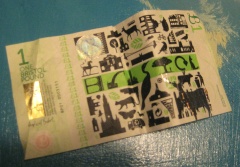– Invitation to an open meeting
March 27th 5.30pm
It’s a couple of years now since we first started exploring a local currency for Birmingham. We’ve had a brilliant, largely voluntary, team and great support from the Bristol Pound and the ‘Guild of Independent Currencies’ culminating in a Local Currencies day for the whole UK that took place here in Birmingham at the Impact Hub – an inspirational day for many across the nation seeking to establish local currencies in their towns and cities.
This learning experience has been an early positive impact of our local currency initiative, and has helped us with some findings we hope to share with you during the open meeting.
The benefits of the Birmingham Pound – a reminder
We believe a ‘Birmingham Pound’ would represent a great opportunity for Birmingham. Even more so in the post-Brexit world, where more and more people feel left behind and powerless in the face of complex global economic systems from which they see no benefit.
 While having well recognised international brands on the high street brings some advantages, the fact is that when you spend a pound in somewhere like ‘Starbucks’, not much of the money stays in the locality, or even in the UK.
While having well recognised international brands on the high street brings some advantages, the fact is that when you spend a pound in somewhere like ‘Starbucks’, not much of the money stays in the locality, or even in the UK.
But a pound spent in a local currency will circulate around and around the area, something economists call a ‘multiplier effect’ – meaning more of your money benefits people in your city. This is because a pound in a local currency can’t be spent outside the area.
There are environmental benefits too: when you increase spend within the geographical confines of a town or city, supply chains stretch to its hinterland and not halfway round the world. Then there’s the sense of pride in our city that a local currency brings, making the diverse, independent businesses and cultures of Birmingham something to celebrate.
It is the clearest and most visual way of demonstrating the value of local purchasing and has great potential to change understanding and behaviour.
Why haven’t we kicked things off yet?
Like many other currencies we have been looking at ‘piloting’ in specific areas of the city. Keen to benefits those currently left out of the city’s prosperity, we have been exploring neighbourhoods with dynamic but not prosperous local economies and lots of ‘social capital’ (community-spiritedness). We want to start away from the ‘usual suspects’ of trendy-leftie areas, to make sure it is a currency everyone feels is theirs to use. But we also want get the financial model right: it has to sustain itself. In this we’ve had the advantage of being able to learn from the experience of established currencies.
We are aware that Bristol has had access to significant grant funding – as befits the first big initiative of its type. We’re happy with seed funding to explore and kick off our currency, but we don’t feel it’s appropriate or realistic for a local currency to be permanently grant-dependent, particularly when there is so much hardship to which grant resources should be directed.
So over the autumn we’ve been using data from other currencies to model how the income and expenditure of the Birmingham Pound might work out over a solid 5 year plan.
Operating costs are largely for staff time in communicating and marketing the scheme, in printing notes and for the system that handles the electronic transactions.
The in-built sources of revenue for a local currency are:
- Transaction fees, ideally set cheaper than those charged by banks for electronic transactions to help the scheme’s attractiveness.
- Note retiral: the ‘bank notes’ have a use-by date, firstly to encourage people to spend them and secondly because a lot of people will take notes out of the system to keep as souvenirs (I have a Bristol and a Brixton note I keep to show people) so it makes sense to have a fixed point at which the value of these can be used to support the scheme.
B ased on staffing and system costs from Bristol, and repaying community investment at a fair rate for the initial outlay, we calculated we would need to get up to £9m in transactions a year to sustain a currency through these sources alone. This is of course a significant challenge and beyond where Bristol is now [1]. But here are some ways we could make this stack up:
ased on staffing and system costs from Bristol, and repaying community investment at a fair rate for the initial outlay, we calculated we would need to get up to £9m in transactions a year to sustain a currency through these sources alone. This is of course a significant challenge and beyond where Bristol is now [1]. But here are some ways we could make this stack up:
1) Maximising the transaction numbers and scale through an emphasis on business to business trading: While the public perception of the local currency is almost like an independent shop loyalty card, primarily about the customer/retailer relationship, it is the business to business aspect where the transactional value could really start to mount.
2) A small amount of economic development funding based on evidence of impacts: As a country we spend significant funds on economic development, and the Birmingham Pound could be an effective part of that spend (potentially much more redistributive than the massive subsidy we give FDI [2])- so long as we can demonstrate the value coming out at the other end. So we are also exploring the quantitative and qualitative impacts of the local currencies, to assess what ongoing investment is justified.
3) Combining the Birmingham Pound offer with related services that help in the same goal and cross-subsidising this way. For example, we can provide small business marketing, and could sell services tailored specifically for the needs of locally owned businesses through a broader Birmingham Pound co-operative. We’ve seen this concept work AND fail elsewhere, so it needs some attention to know whether this is a viable market for us.
So, as we mentioned above, we would now like to invite you to an event on Monday March 27th at 5.30pm, at Royal Bank of Scotland in Birmingham, where we will present our findings and show you both the inspiration and the nuts and bolts of a Birmingham Pound, so you can help us scrutinise and challenge what we have found and agree a way forward. Book your place here.
We look forward to seeing you there!
Karen Leach
[1] Though Bristol are aiming for this scale in the next 2 years.
[2] The UK public cost per job is 80% higher for Foreign Direct Investment than for ‘indigenous’ businesses.